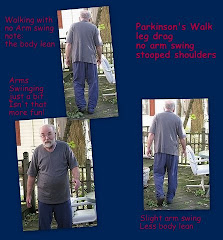Steve had several PD precursor symptoms for years. Some motor symptoms appeared early but did not interfere with lifestyle. Postural Instability appeared about a year prior to his diagnosis. The appearance was subtle. He would climb a ladder to perform some honeydo chore and come back down saying that he felt uncomfortable, unsteady, not right about being on a ladder. And this was inside the house. He felt that the sensation was real - as his wife I had some doubts. He was right; I wish he'd been wrong. He was exhibiting one of the Big 4 Parkinson's symptoms.
What is Postural Instability? To my eyes it is the failure to be able to identify the vertical but really it is much more. It occurs when reflexes are unable to adjust or compensate for sway, vertical, horizontal and diagonal and environmental changes. Gait Disturbances such as freezing or the loss of the natural rhythms which initiate and maintain gait, the rhythm aids in turning and in stride length are interrupted or short circuited.
An easy way to identify how a PwP might sense the problem is to visualize a set of steps which do not conform to the normal rise and/or tread depth. Imagine (feel) walking up or down the stairs where the next step you take is not the same height difference as the previous step so that the spacing rhythm is disrupted. Perhaps one riser is the code max of 7.75" while another is 8" or 8.5". You automatically reach for the next step and it isn't where it is supposed to be. I've seen it when an amateur cuts a step stringer and it can kill you. Your body has a natural rhythm when descending or ascending a flight of stairs. You can simulate this by placing a magazine on one step, two on the next, none after that. You'll feel very disconcerted and off balance. You grab for the handrail. What should come naturally doesn't. That's just a part of Postural Instability and Gait Disturbance.
We recently received an email asking for information about a procedure known as ExAblate®. The writer wanted to know if there was hope for Parkinson's patients with Postural Instability after she had seen the Diane Sawyer segment on ABC World News in which a ET patient of Dr William Jeff Elias discussed her Essential Tremor life before and after this unique targeted laser procedure. Although there may be a genetic link between some cases of ET and some cases of PD, the targeting will be different.
ExAblate® is a procedure done using Magnetic Resonance guided Focused Ultrasound *MRgFUS) technology developed by a Swiss company, InSightec. Although there is a study underway for Parkinson's patients, it will only take place at the Center of Ultrasound Functional Neurosurgery in Solothurn, Switzerland. The studies being conducted by Dr William Jeff Elias in the US are directed to Essential Tremor as the specific brain targets have been identified.
The Parkinson's study by Insightec is geared towards long-term chronic, therapy-resistant movement disorders. Perhaps there will be some surprise results as Postural Instability (PI) or Postural Instability and Gait Disturbances (PIGD) are inadvertently addressed as well. We can only hope.
There is some research in progress. In 2009 the Michael J Fox Foundation awarded five research grants totaling $2 million for research addressing Postural Instability and Gait Disorders.
Over the last few years there has been research into a part of the brain stem known as the pedunculoponitine nucleus (PPN) which is a bi-lateral target for stimulation to address gait freezing. We plan to write more about it. The PPN processes sensory and behavioral data, is related to arousal, attention. learning, locomotion rewards and voluntary limb movement. While the PPN gets input from several areas of the brain, it sends but does not receive information from the substantia nigra pars compacta. Autposies of PD brains show degeneration of the pedunculopontine nucleus. Researchers identifed the PPN as a target for Deep Brain Stimulation and the first PPN DBS surgeries have shown promise. The point is that the PPN seems to be very significant in Parkinson's disease.
While there don't seem to be medications which work effectively to address Postural Instability, there are some exercises which might help if done on a regular basis. We covered marching in place as a chair exercise a few years ago. Shoulder exercises are important for posture and range of motion. This week we'll post two more excellent exercises.
Cerebral blood flow changes induced by pedunculopontine nucleus stimulation in patients with advanced PD
Topical organization of the pedunculopontine nucleus by Christina Martiniz-Gonzalez, J Paul Bolan and Juan Mena-Segovia from the Medical Research Council Anatomical Neuropharmacology Unit, Dept of Pharmaacology, University of Oxford, Oxford, UK


















No comments:
Post a Comment
Welcome to Parkinsons Focus Today.
We are delighted to hear from you by comment here
or through email as found in Contact Us.
Please do not include email addresses if leaving a comment online.
Email addresses are used only for email responses.
Spammers take note: your messages will not be published. The comments section is for an exchange of ideas, not for backlinks.